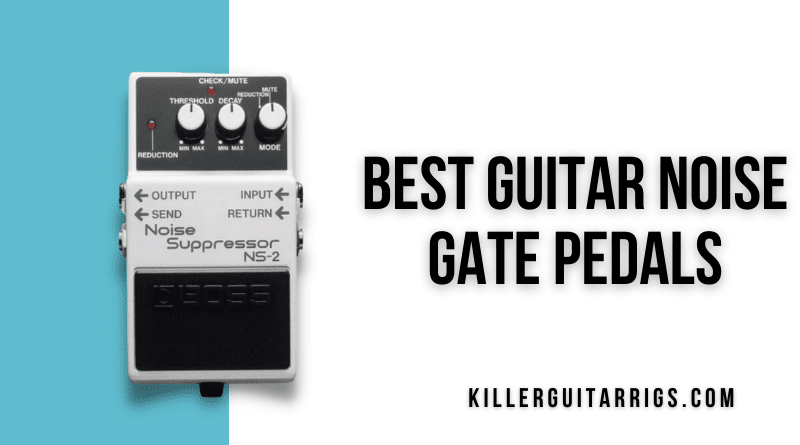One of the key features of the best noise gate pedals is the elimination of unwanted noise while keeping your tone intact.
There’s nothing musical about 60 cycle hum or ear-splitting feedback. Whether at a gig or practicing at home, rig noise is distracting at best and in many cases can absolutely overpower a recording or live mix.
Some mistakenly believe that noise only affects overdrive, fuzz, or distortion pedals, but this isn’t the case. Yes, high gain can influence noise, but it may also arise from faulty shielding, cheap components, or bad grounding.
So, what’s the solution? The easiest answer is to add a noise gate into your signal chain. Noise gates quite simply eliminate any sounds below a set threshold. They do a great job of killing 60 cycle hum and the noise caused by electrical interference.
In this KillerGuitarRigs Review, we’ll be taking a look at the 7 Best Noise Gate Pedals on sale today. When reviewing the pedals we looked at features, build quality, and effectiveness in taming a noisy rig. To try and get the best feel for how these pedals killed noise, we used a Fender Player Stratocaster into a Marshall Origin 20.
If you’re looking for ways to tackle hum, you’ve come to the right place!
Read more about our review process.
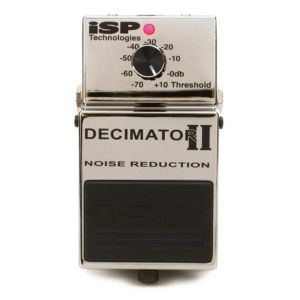
ISP Technologies Decimator II
Features: Linearized time vector Processing, Direct instrument tracking, Solid metal construction
Benefits: Slick note decay, Excellent release response smoothness, Tour grade build quality
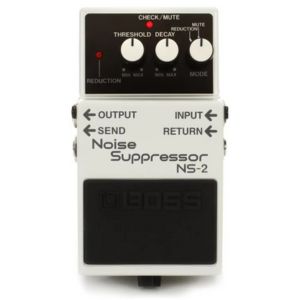
Boss NS-2 Noise Suppressor
Features: Guitar and bass compatible, Threshold and decay controls, Noise detection circuit
Benefits: Excellent preservation of natural attack, Easy to shape suppression, Solid noise reduction performance
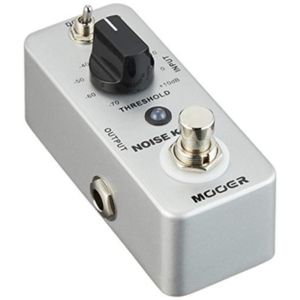
Mooer Noise Killer
Features: Hard/Soft suppression modes, Metal body, Small footprint
Benefits: Easy to adjust suppression type, Built to last, Industry standard threshold range
Contents
Our Top 3
The Boss NS-2 is our Top Pick for best noise gate pedal, continuing to reign the noise gate selection. It’s effective, built like a tank, and easy to use. Whether you play ’80s rock or djent, this pedal will do an efficient job of eliminating unwanted noise. It isn’t True Bypass, but there’s no tone degradation. The asking price is reasonable as well.
The Mooer Noise Killer MNR1, our Best Budget Pick, is a True Bypass noise gate pedal with the smallest possible (micro) dimensions. In addition to saving space on the pedalboard, it sports a modest price tag. It may not have all the bells and whistles, but it’s a highly-capable noise gate with a full metal shell, quality circuitry, and True Bypass.
The ISP Technologies Decimator II was our Editor’s Choice, and is a testament to the flawless execution of a simple concept. It’s transparent, effective, and as robust as the NS-2. It does an impressive job of eliminating noise without affecting the guitar tone. Plus, it’s available in a micro format and you can link two of these pedals to track your guitar signal directly.
Individual Reviews

Boss Noise Suppresor NS-2
A classic with all of the rugged functionlity you expect from Boss.
Professionals and amateurs have turned to the NS-2 for years, and it's no surprise. It offers rock solid construction, excellent performance, and also the flexibility of battery and dc power options.
The Boss NS-2 has been around since the late 1980s. Over three decades, it has featured in the rigs of touring giants like U2, Slipknot, and Metallica among others. The main draw of the NS-2 is its rugged build, efficient features, and ease-of-use.
The Boss NS-2 included one input, one output, and a send/return to act as its own loop. The send/return feature was flexible and was really useful when we weren’t using the effects loop. Like most Boss pedals, the NS-2 can be powered with a 9V battery or adapter, although the adapter wasn’t included.
The NS-2’s top panel featured a threshold and decay knob to dial in the elimination and suppression. The decay knob controlled the attenuated signal. Setting it for longer allowed more time for the filtered signal to fade out.
The mode knob was another notable feature of the NS-2. It had a dual-mode operation, with Reduction and Mute modes. Reduction was the normal mode, meaning the gate worked when we activated the pedal with the footswitch and stopped when we disengaged it.
Mute mode was an ‘always-on’ mode, a way to constantly use the suppression and toggle it on/off with the foot switch. Boss added an extra LED indicator (labeled Reduction) to display the real-time status of the pedal in Mute mode to avoid any confusion, something we found particularly useful.
Verdict: The Boss NS-2 is reliable, rugged, and has just the right features for a workhorse pedal. It’s a pedalboard staple that continues to retain its strong position in the segment. The modest price tag, demonstrable reliability, and the 5-year warranty make it a fantastic choice for those seeking a blend of price and performance.

Mooer Noise Killer
A micro true bypass pedal with a micro true value price tag.
This little micro pedal offers exceptional value for money. It's well made, and offers better than average performance at a price that's not going to break the bank.
Mooer might be a newer brand in the FX segment, but in a short time they’ve earned a solid reputation for creating quality pedals. The MNR1 is no exception. This mini pedal is great for folks who want a set-it-and-forget-it kind of noise gate.
It had a simple one-knob operation and extremely compact dimensions. There were two jacks for input and output, an LED On/Off indicator, and a durable metal foot switch. The lone knob/dial on the pedal allowed us to set the threshold range between -70dB and +10dB. Above the knob was a toggle switch to access the two working modes – Hard and Soft.
In the Hard mode, we got a sharp and accurate cut for fast start/stop riffs. In Soft mode, we found it delivered a more measured decay that suited non-metal genres. Soft mode was also better for solos and sustained notes.
The metal housing was super sturdy and the pedal weighed next to nothing. Even though it was lightweight, it’s still clear that it was built to withstand abuse. The only downside is that it needs 9V power using a DC adapter. There was no option to use a 9V battery, which is expected from compact pedals.
Verdict: The Mooer MNR1 is petite, rugged, and ready for action. It’s easy to operate and offers convenience at a compelling cost. It isn’t as versatile as the other full-sized options in our roundup. Nevertheless, it does exactly as advertised and can be a fantastic addition to a busy pedalboard. Whether you’re struggling with hum from a single-coil guitar or just trying to keep costs down, this is a great choice for not a lot of money.
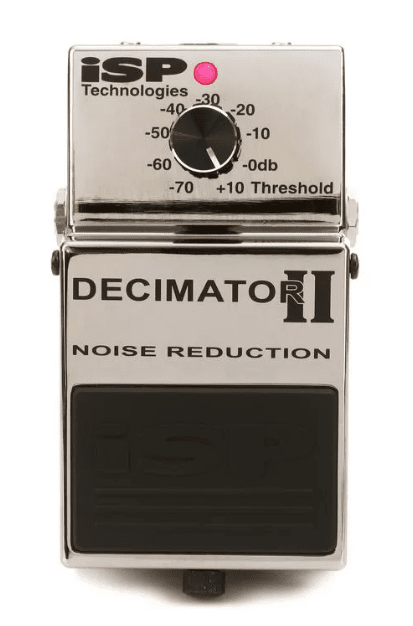
ISP Technologies Decimator II
High-quality noise reduction with send/return and Link In/Out capabilities.
If you're looking for class leading noise reduction performance, this is the pedal for you. It's built to withstand the harshest touring conditions, and can tame the hottest of hot pickups, giving you incredible control over your sound.
The ISP Decimator – first generation – was a big hit among those who swore by its best-in-class noise gating capabilities. While not much has changed in the appearance, the 2nd Gen has received some patented improvements. It featured Linear Time Vector Processing in the expander tracking for a buttery smooth decay, transparent release, and enhanced release response.
Construction-wise, the pedal was a solid hunk of metal, as sturdy and stout as they get. It featured a Boss-style design with guitar in/out jacks to the sides and link in/out on the back panel. The pedal was easy to use thanks to its single knob that let us set the threshold between -70dB and +10dB. The pedal was able to be powered by a 9V battery or standard DC adapter.
One of the coolest features was we could network it to another pedal to track the guitar input signal. Yes, two Decimator II pedals can be operated in unison. For example, you can place one in front of the preamp and another for the effects loops. We only had one pedal for the test, so we didn’t get to check this out, but if this is something you need from a pedal, the Decimator is capable of meeting that requirement.
Not only was this pedal super easy to use, but we found it did a great job of taming the frankly unruly single-coil pickups on our Strat. It got rid of the noise without muddying any notes or coloring the tone. It’s one of the best-selling noise reduction pedals and you’ll realize exactly why if you decide to invest in one.
Verdict: If you’re looking for a one-stop noise solution, the Decimator II does a great job without killing your natural tone. You may not encounter ISP Technologies in most pedal roundups, but they’ve completely outclassed the segment with the Decimator II. It offers the whole range of features and cleans everything up nicely. They even offer it the micro-format with the ISP Deci-Mate.
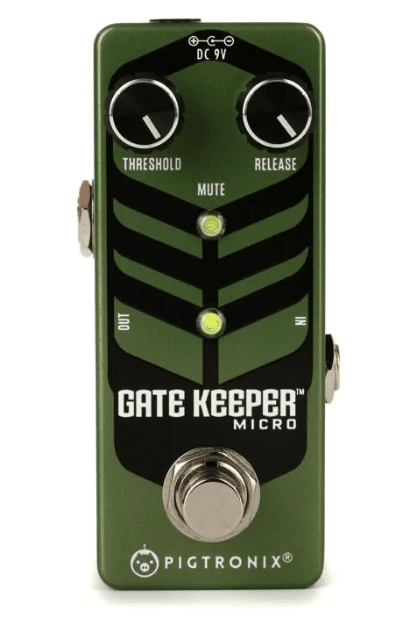
Pigtronix Gatekeeper
A responsive, small-sized, all-analog pedal with JFET circuitry.
This is a premium, all analog pedal with studio grade circuitry, designed to eliminate the noise you don't want, while leaving your tone completely unaffected. It doesn't come cheap, but the results speak for themselves.
The Pigtronix Gatekeeper is a relatively expensive alternative to the Mooer MNR1. However, the price difference is reflected in its performance. It’s a True Bypass, all-analog pedal with studio-grade JFET circuitry, so it won’t adversely affect your tone.
The Gatekeeper excelled at blocking out hum, white noise, and other intrusive sounds. It’s designed for ultra-high-gain rigs that are constantly plagued by noise the moment you stop playing. We found it to be fast and efficient with a smooth transient response for nice, predictable decay.
There were 2 knobs on the pedal. The wide-range threshold adjusted the dynamic to open/activate the noise gate. Once that was set, the release knob setting adjusted the time it took to close the gate. The simple 2-knob operation is a blessing for anyone who likes to keep things simple.
The pedal had a very small footprint (1.5″ L x 3.75″ W x 1.75″ H), so it’s a great option if you’re short on space on your pedal board. We were able to power it with either a 9V DC power supply or battery, and it weighed a meager half a pound. It also featured a mute LED that visually indicated whether the signal has fallen below the threshold.
It had a variable release time with 100% attenuation during gating. If we had any criticism, it would be that the knobs were overly sensitive and this made fine adjustments a little difficult, especially under live-performance conditions.
Verdict: The Pigtronix Gatekeeper is a reasonably priced studio-quality pedal. It’s response time is lightning-fast, which makes it an excellent choice for hi-gain metal styles. The JFET circuitry really delivered when it came to killing 60 cycle hum, and any guitarist who wants to push their amp’s gain and volume to the max will definitely get on well with the Gatekeeper.
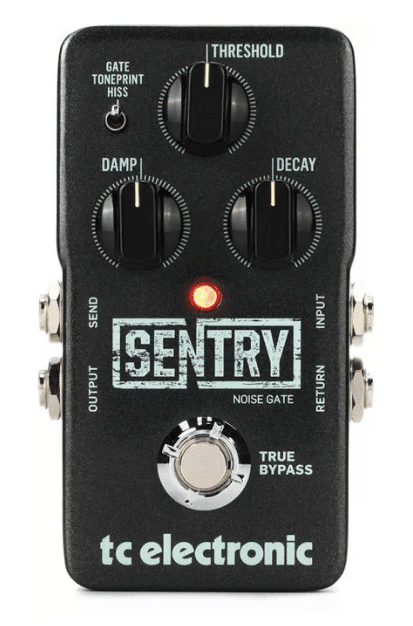
TC Electronic Sentry
A TonePrint enabled noise gate with multiband mode and True Bypass.
Players looking for extreme control should absolutely consider this pedal. It offers multiple adjustment pots, and allows players to control specific frequencies fine precision. It's well made, nd the versatility alone should make it worthy of your consideration.
We thought the TC Electronic Sentry was a versatile pedal thanks to the hard, and multi-band gating. It’s even more appealing if you are a fan of TC Electronics and their TonePrint app. The fine-tuning capabilities helped elevate this pedal toward the top of the pack when it comes to zeroing in on problem frequencies.
The pedal had three knobs: Threshold, Decay, and Damp. Threshold allowed us to dial in the sensitivity, Damp let us set how fast the gate closed, and Decay regulated the fading out of notes once the gate closes.
To the upper-left corner, there was a 3-way toggle switch for Gate/TonePrint/Hiss. Gate is the first mode that works as a traditional noise gate for hard gating. Hiss is a multi-band option to eliminate splits and hisses from single-coils or clean tones. We thought it was most effective in the traditional Gate mode, which delivered effective reduction of single-coil hum.
TonePrint is the USP of the pedal. Accessed from the TC Electronics app, it allowed us to dial in ultra-precise adjustments that the knobs couldn’t accomplish. This was a really cool feature, but in reality we don’t think it’s one we’d find ourselves using often.
The pedal also featured an LED to indicate when the gate opens and send/return jacks to gate the direct guitar signal.
Verdict: The TC Electronic Sentry has everything you could possibly ask of a noise gate in your signal chain. It’s a favorite of big-name metal guitarists, featuring regularly in the rigs of Scott Ian, Gary Holt, Devin Townsend, Misha Mansoor, and Brian “Head” Welch. That’s as good an endorsement for metal guitarists as you can get.
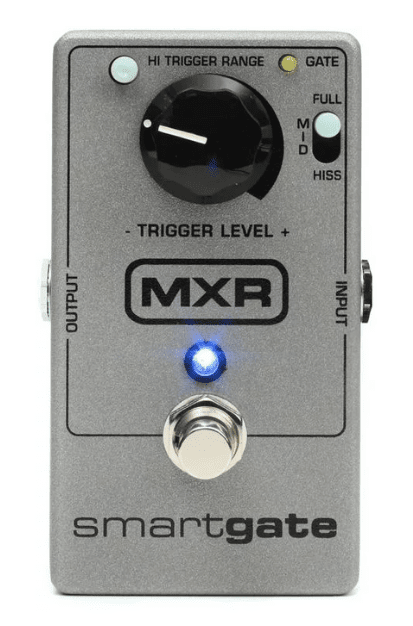
MXR M135 Smart Gate
A transparent pedal with three selectable modes and a Hi-trigger range button.
When simplicity is the order of the day, this MXR pedal answers the call. It's exceptionally easy to use, it offers excellent noise reduction performance, and doesn't affect or color tones in any way.
The MXR M135 Smart Gate is a versatile and complex noise gate that delivered dynamic performance across the board. The housing of this pedal had the typical MXR quality, with a rugged metal enclosure and a high-end footswitch. It was clear from the get-go that this thing was build to take punishment.
The top panel featured a single threshold knob that regulated gate exposure and an LED indicator for the reduction levels. In terms of operation, the pedal had a 3-way selector to toggle between the 3 modes of noise reduction: Full, Mid, and Hiss.
Full mode delivers 100% attenuation of the signal. It may kill sustain but it’s fantastic for faster playing styles that demand absolute precision. Mid mode gave us a partial gating effect that was the best setting for killing single-coil hum without killing the sustain.
Hiss mode dealt with most of the extra hiss we had on the clean channel. This was fantastic for killing high-frequency hiss, particularly hiss from cabinet tweeters. It also had a Hi-Trigger Range button that toned down the gating within the volume band. It cut the squeal well, but it did affect the sustain a little.
The pedal is available in gray and black. It featured input and output jacks and can be powered with a single 9V battery or a standard adapter. Unusually, it had a hardwire bypass, which isn’t the same as true bypass (considered the gold standard), but we didn’t notice any loss of tone or tone coloration.
Verdict: Whether you have a hot-rodded Strat or a chug-ready ESP, the MXR Smart Gate is a great choice for your pedalboard. It offers good value for money and has an intelligent gating system (smart gate) that adjusts to your playing speed. The gate opens rapidly during fast phrases and riffing and is relatively slow with laidback playing, especially sustained notes.
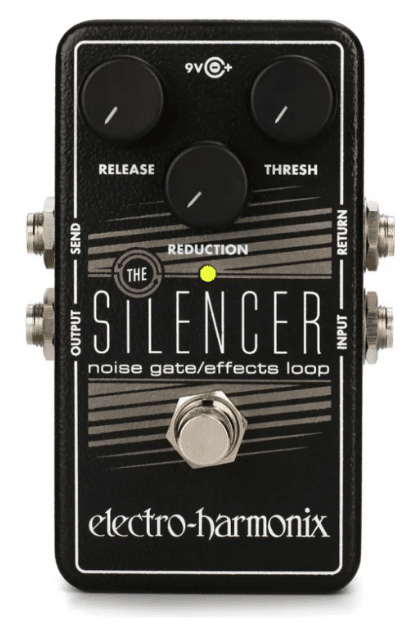
Electro Harmonix Silencer Noise Gate
Affordable but fully featured noise gate from Electro Harmonix.
If you need a rock solid, giggable pedal that's reliable, functional, and affordable, take a look at this Electro Hamonix Silencer. It offers the convenience of both battery and 9v power, and a huge range of noise reduction from -70dB to +4dB.
The EHX Silencee is a great pedal with an all-analog circuit. It was about as sturdy as they come, with a rugged chassis and good quality dials. The front panel had a three-knob layout, an LED indicator, and a sturdy footswitch. The knobs allowed us to fine-tune levels for Threshold, Reduction, and Release.
Threshold determined the level at which the gate opened, Reduction decided how much the level was reduced, and Release adjusted the decay after the signal drop. We were able to dial in a -70db to +4 dB reduction and 4ms to 4 seconds variable release.
It was a full-featured pedal with input/output jacks and send/return jacks and an AC jack to power the pedal with an adapter. We were also able to power it with a 9V battery. The pedal had ‘buffered bypass’ instead of true bypass. This kept the effects loop in the signal path even when the pedal was disengaged. We did notice a slight signal drop as a result, but the vast majority of users won’t pick up on this.
The send/return jacks made it ideal to combat a single noisy pedal in a busy fx loop. The decay sounded smooth and there was no degradation of tone or shortening of sustained notes.
Verdict: The EHX Silencer is amongst the cheapest of the full-featured noise gate pedals. It could have been a contender for our top pick, but the buffered bypass just didn’t perform as well as the true bypass on the other pedals. Nevertheless, it delivers excellent performance in terms of noise reduction, especially for the price.
How to Choose The Right Pedal For You
What Is a Noise Gate Pedal? What Does It Do?
A noise gate pedal is designed to remove unwanted noise, such as mains hum (60hz cycle hum) from single-coil pickups. They are also used in an effects loop to tame a single noisy pedal (usually dirt or compressors), or the preamp in your signal chain. A good noise gate pedal is transparent and acts subtlety, so it shouldn’t color the tone or cause adverse effects like shortening of sustained notes.
Is a Noise Gate Pedal Essential for Metal Guitarists?
Metal genres, especially modern metal, involves the use of cranked-up dirt and extended-range guitars (7- or 8-string). Guitarists typically play lightning-fast riffs with start/stop and palm-muted components. Even the slightest noise will make it hard to sound clean, because it corrupts the silent parts of the riffs.
In this scenario, a noise gate after the dirt section in the signal chain or the effects loop can be a huge help. You can set a high threshold with a rapid closing of the gate to fix this kind of noise.
Do You Need a Noise Gate Pedal?
Every guitarist and their rigs are unique, so it’s hard to make a sweeping generalization. That said, noise gate pedals are crucial for any rig that’s plagued by unwanted feedback, noise, or electrical interference such as buzzing/hissing, mains hum (or simply humming), or the sort of ‘white noise’ that commonly happens when coupling high volume with high gain.
Where Do you Place a Noise Gate Pedal in the Signal Chain?
Generally, noise gate pedals are either placed in an effects loop or after the dirt (distortion/overdrive) section. They should be placed before the modulation (ambient) and time-based pedals such as reverb and delay.
Placing them after the time-based pedals will negatively alter the sound. For instance, a noise gate may abruptly cut short a reverb trail or diminish the repeat on the delay. As ever, you are free to use them anywhere if you want to experiment and create atypical sounds.
Final Thoughts
If you are struggling with pedal-generated hum, the first step is to check your power supply. A fully-isolated power supply is crucial before you look for further solutions. We recommend the 1 Spot PRO CS12 or MXR Iso-Brick. Once you have that sorted, you can reliably pick any of the best noise gate pedals from our roundup that suits your needs and budget.
To recap, our Top Pick was the Boss NS-2, a rock-solid classic that gets the job done reliably at a great price point. The Mooer Noise Killer MNR1 was our Best Budget pick thanks to its surprisingly powerful performance, small footprint, and even smaller price tag. Finally, our Editor’s Choice was the ISP Technologies Decimator II, which offers the perfect combination of performance and build quality. The price was higher than average, but we think it was absolutely worth it.

ISP Technologies Decimator II
Features: Linearized time vector Processing, Direct instrument tracking, Solid metal construction
Benefits: Slick note decay, Excellent release response smoothness, Tour grade build quality

Boss NS-2 Noise Suppressor
Features: Guitar and bass compatible, Threshold and decay controls, Noise detection circuit
Benefits: Excellent preservation of natural attack, Easy to shape suppression, Solid noise reduction performance

Mooer Noise Killer
Features: Hard/Soft suppression modes, Metal body, Small footprint
Benefits: Easy to adjust suppression type, Built to last, Industry standard threshold range
Check out these other articles you might like:

